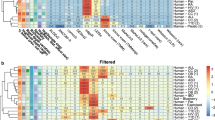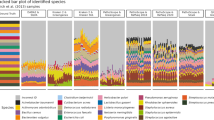Abstract
We present an algorithm, PyroNoise, that clusters the flowgrams of 454 pyrosequencing reads using a distance measure that models sequencing noise. This infers the true sequences in a collection of amplicons. We pyrosequenced a known mixture of microbial 16S rDNA sequences extracted from a lake and found that without noise reduction the number of operational taxonomic units is overestimated but using PyroNoise it can be accurately calculated.
This is a preview of subscription content, access via your institution
Access options
Subscribe to this journal
Receive 12 print issues and online access
$259.00 per year
only $21.58 per issue
Buy this article
- Purchase on Springer Link
- Instant access to full article PDF
Prices may be subject to local taxes which are calculated during checkout


Similar content being viewed by others
References
Margulies, M. et al. Nature 437, 376–380 (2005).
Quinlan, A.R., Stewart, D.A., Stromberg, M.P. & Marth, G.T. Nat. Methods 5, 179–181 (2008).
Vacic, V., Jin, H., Zhu, J.-K. & Lonardi, S. Pac. Symp. Biocomput. 13, 75–86 (2008).
Fraley, C. & Raftery, A.E. Comput. J. 41, 578–588 (1998).
Schloss, P.D. & Handelsman, J. Appl. Environ. Microbiol. 71, 1501–1506 (2005).
Huber, J.A. et al. Science 318, 97–100 (2007).
Roesch, L.F. et al. ISME J. 1, 283–290 (2007).
Sogin, M.L. et al. Proc. Natl. Acad. Sci. USA 103, 12115–12120 (2006).
Quince, C., Curtis, T.P. & Sloan, W.T. ISME J. 2, 997–1006 (2008).
Wang, G.C.Y. & Wang, Y. Microbiology 142, 1107–1114 (1996).
Ashelford, K.E., Chuzhanova, N.A., Fry, J.C., Jones, A.J. & Weightman, A.J. Appl. Environ. Microbiol. 72, 5734–5741 (2006).
Cole, J.R. et al. Nucleic Acids Res. 37, D141–D145 (2009).
Liu, Z.Z., DeSantis, T.Z., Andersen, G.L. & Knight, R. Nucleic Acids Res. 36, 11 (2008).
Lozupone, C. & Knight, R. Appl. Environ. Microbiol. 71, 8228–8235 (2005).
Eriksson, N. et al. PLOS Comput. Biol. 4, 13 (2008).
Needleman, S.B. & Wunsch, C.D. J. Mol. Biol. 48, 443–453 (1970).
Katoh, K., Kuma, K., Toh, H. & Miyata, T. Nucleic Acids Res. 33, 511–518 (2005).
Huse, S.M., Huber, J.A., Morrison, H.G., Sogin, M.L. & Mark Welch, D. Genome Biol. 8, 9 (2007).
Edgar, R.C. Nucleic Acids Res. 32, 1792–1797 (2004).
Altschul, S.F. et al. Nucleic Acids Res. 25, 3389–3402 (1997).
Acknowledgements
We thank K. Ashelford (University of Liverpool) for the preliminary bioinformatics analysis of the sequencing data and for making the Mallard code publicly available, S. Huse (Marine Biological Laboratory, Woods Hole) for providing the quickdist algorithm and R. Knight for commenting on the manuscript. C.Q. is supported by a Lord Kelvin Glasgow University fellowship, W.T.S. by an Engineering and Physical Sciences Research Council Advanced Fellowship, R.J.D. by a Royal Society fellowship. The Natural Environment Research Council funded sequencing.
Author information
Authors and Affiliations
Contributions
T.P.C., R.J.D., I.M.H., C.Q. and W.T.S. designed the study. C.Q. devised algorithms and wrote software. A.L. and C.Q. performed analysis. R.J.D. and L.F.R. performed experiments. N.H. oversaw sequencing. T.P.C., R.J.D., N.H., I.M.H., A.L., C.Q., L.F.R. and W.T.S. wrote the paper.
Corresponding author
Supplementary information
Supplementary Text and Figures
Supplementary Figure 1 and Supplementary Tables 1–3 (PDF 72 kb)
Supplementary Software
Archive containing Readme file and source code. (ZIP 303 kb)
Rights and permissions
About this article
Cite this article
Quince, C., Lanzén, A., Curtis, T. et al. Accurate determination of microbial diversity from 454 pyrosequencing data. Nat Methods 6, 639–641 (2009). https://doi.org/10.1038/nmeth.1361
Received:
Accepted:
Published:
Issue Date:
DOI: https://doi.org/10.1038/nmeth.1361
This article is cited by
-
On the holobiont ‘predictome’ of immunocompetence in pigs
Genetics Selection Evolution (2023)
-
Highly multiplexed targeted sequencing strategy for infectious disease surveillance
BMC Biotechnology (2023)
-
Metabarcoding analysis of the bacterial and fungal communities during the maturation of preparation 500, used in biodynamic agriculture, suggests a rational link between horn and manure
Environment, Development and Sustainability (2023)
-
Cold sediment microbial community shifts in response to crude oil water-accommodated fraction with or without dispersant: a microcosm study
Environmental Science and Pollution Research (2023)
-
Interaction between endometrial microbiota and host gene regulation in recurrent implantation failure
Journal of Assisted Reproduction and Genetics (2022)



